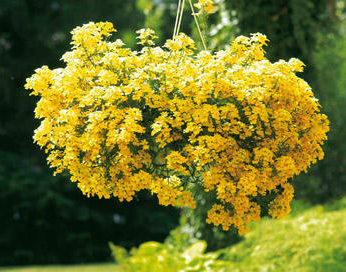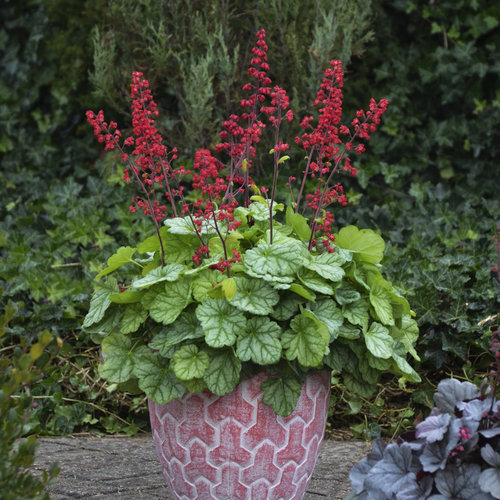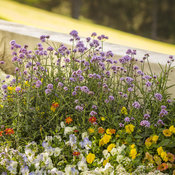It's a Cold, Cruel World
This article explains the ins and outs of hardening-off plants so they are better able to handle the rigors of the outside environment.
 I lived in St. Paul, Minnesota for three years while I attended graduate school at the University of Minnesota. When the weather first started turning cold in fall, 20 (F) degrees felt really cold. Inevitably, it seemed, there would be a cold snap with temperatures in the negative 20's (F) or colder. After one extended cold snap, I distinctly remember the temperatures finally climbing to 20 (F) degrees. It felt so warm I didn't button my coat or wear my gloves. Students abandoned the tunnel system that allowed travel over much of campus without going outside in favor of snowball fights and fresh air. Over the course of the long cold winter my body had adjusted to the colder temperatures and what once was freezing cold felt, if not warm, at least not cold. I have always found the ability of our bodies to adjust to changing temperatures fascinating. Why I am telling you all of this? Because plants have this same ability to adapt to cold temperatures, they just can't talk about it.
I lived in St. Paul, Minnesota for three years while I attended graduate school at the University of Minnesota. When the weather first started turning cold in fall, 20 (F) degrees felt really cold. Inevitably, it seemed, there would be a cold snap with temperatures in the negative 20's (F) or colder. After one extended cold snap, I distinctly remember the temperatures finally climbing to 20 (F) degrees. It felt so warm I didn't button my coat or wear my gloves. Students abandoned the tunnel system that allowed travel over much of campus without going outside in favor of snowball fights and fresh air. Over the course of the long cold winter my body had adjusted to the colder temperatures and what once was freezing cold felt, if not warm, at least not cold. I have always found the ability of our bodies to adjust to changing temperatures fascinating. Why I am telling you all of this? Because plants have this same ability to adapt to cold temperatures, they just can't talk about it.
In plants, the process of acclimation to changing weather is often referred to as hardening-off. Most often hardening-off is associated with acclimating plants to cold temperatures, but it can also refer to acclimating to hot temperatures, wind or sun. Plants growing in your garden will naturally harden-off as the temperatures cool in the fall. They naturally harden-off to wind and sun and rain as they poke through the ground in the spring. The process is completely natural. Plants that start life in a greenhouse or under lights in your home, on the other hand, spend their time in pampered comfort. The temperature is just perfect, the wind doesn't blow, water is gently and carefully applied, the sun never scorches and rain never pounds. It is an idyllic life, to say the least. This life of perfection, however, doesn't prepare plants to move out into the cold, cruel world.
Plants that are pampered will often be "soft," again just like humans. How can you tell?
- Plants that have been exposed to harsher environments have tougher, dark green foliage, won't lose water as fast (they have thicker leaves) and are less likely to sustain sun and wind damage.
- Plants that are "soft" have medium-pale green foliage; they will transpire (sweat) water more quickly, get sun burned leaves if they get too much sun (like people are more likely to sunburn in spring compared to mid-summer), and a windy day can cause them to wilt even if the soil is moist (just like our skin can chap in the wind). Plants, like people, will perform better with a little bit of seasoning.
Hardening-off is important because it reduces stress on your plants. You may have noticed that it can sometimes take several weeks for newly transplanted plants to really take off and begin growing. Some of this delay is natural, since the plant will generally put energy into establishing a larger root system to support the plant before working on foliage growth. However, this delay will be increased if the plant is stressed. Stress can have long lasting impacts on a plant, especially with annuals.
For an annual, the whole point of flowering is to produce seed and insure survival of the species. If a plant is stressed, a signal will be sent to the plant that it is in peril. The plant responds to this danger signal by attempting to flower and produce seed as quickly as possible. This rush to flower and produce seed can sap a plant of strength, resulting in underperformance later in the year. Providing conditions that decrease the amount of stress on your plants will help them establish quicker, grower faster, and perform better.
Plants really aren't all that different than us. Doctors have proven that stress can have long term detrimental effects on us too. So, help your plants adapt and they will, in turn, help you de-stress (research has also shown that plants decrease stress in humans).
If you are planting your garden in spring when the weather is lovely, the nights aren't cold, and the sun isn't beating down you have nothing to worry about. The plants will handle adapting to outdoor conditions on their own. However, if you are moving plants out when the weather isn't so perfect your plants will adapt better if you give them a hand. This is especially true when you are getting a jump on the spring season and are planting when the temperatures remain chilly.
Hardening-off Mature Plants for Early Spring Cold Temperatures
There is a natural tendency for gardeners to want to cheat and start planting their garden before the threat of frost has passed. Fortunately, there is a good selection of plants available that can take repeated frost and still be quite happy to bloom away. Plants like Nemesia, Dolce® Heuchera, Argyranthemum, Osteospermum and Verbena will all perform well before the threat of frost has passed in the spring. However, this is only true if you help them adapt to the outdoor environment. To help your plants adapt to cool temperatures:
1. Buy plants that aren't frost sensitive, some plants are more capable of withstanding cold temperatures than others and choosing these plants will be the key to your success.
2. If you have more than a couple of plants, put them in a wagon, wheel barrow or other conveyance that makes it easy to move them around.
3. For one to two weeks move the plants outside while temperatures are warm and then back inside at night when the temperature is cool, a sunny location is best. The second week, as long as night temperatures aren't going to drop below freezing you can leave the plants outside at night. If it is going to get below freezing move the plants indoors. After this two week period you should be able to leave your plants outside.
4. Once they are planted, if the temperatures are going to get very cold, cover them with an old sheet or other cloth to help protect them.
Hardening-off Mature Plants to Full Sun
While most plants will make the move from inside to outside light levels with little problem, you may need to help along some plants. If you have plants that have been kept inside for long periods or they have been grown in shady areas or if they aren't all that sun tolerant, giving them time to adjust to high light will help avoid sunburn on the foliage and a lot of plant stress. Avoiding stress will help the plant grow more quickly and establish better in the garden. The process is very similar to hardening-off to cold temperatures.
To help your plants adapt to sunny conditions:
1. Move plants outside into a shady area for a few days.
2. After a few days move the plants into a sunny area for morning and late day sun but protect them from mid-day sun.
3. After a week or so the plants should be adapted well enough to be left in full sun locations.
Hardening-off Seedlings
Mature plants are one thing, seedlings that have been started indoors and are being transplanted at a very small stage are a bit of a different animal. Seedlings that are started indoors will always need to be hardened off, regardless of the conditions these plants prefer. Seedlings are tender to begin with and those who start life inside ,care will need to be taken as they move outdoors.
To help your plants adapt to life in the great outdoors:
1. Place plants in a wagon, wheel barrow or other conveyance that makes it easy to move them back and forth between the garage or covered patio and outdoors.
2. For one to two weeks move the plants outside while temperatures are warm and then back inside at night when the temperature is cool, place them in a shaded spot when outdoors. After a few days, place them where they receive morning and evening sun but not mid-day sun, as long as it isn't going to freeze the plants can be left outside at night.
3. The second week, leave the plants in full sun and outside as long as night temperatures aren't going to drop below freezing. If it is going to get below freezing move the plants indoors. After this two week period you should be able to leave your plants outside and transplant them to their final homes.
3. Once planted, if the temperatures are going to get very cold, cover them with an old sheet or other cloth to help protect them.
Most plants will be able to adapt to wind and rain with no help from humans. However, if you are going to transplant tender plants, avoid planting on very windy days. There are two problems that can be caused by wind. First, foliage can get beat up and bruised if it is very windy. Most plants will quickly recover from this as new growth comes. The second problem is that wind can cause plants to dry out more quickly. If you see that it is quite windy shortly after transplanting, be sure that there is sufficient water available for the plants.
For the most part, plants will adapt to outdoor conditions on their own but sometimes a bit of a helping hand will get them on their way to full bloom more quickly.










